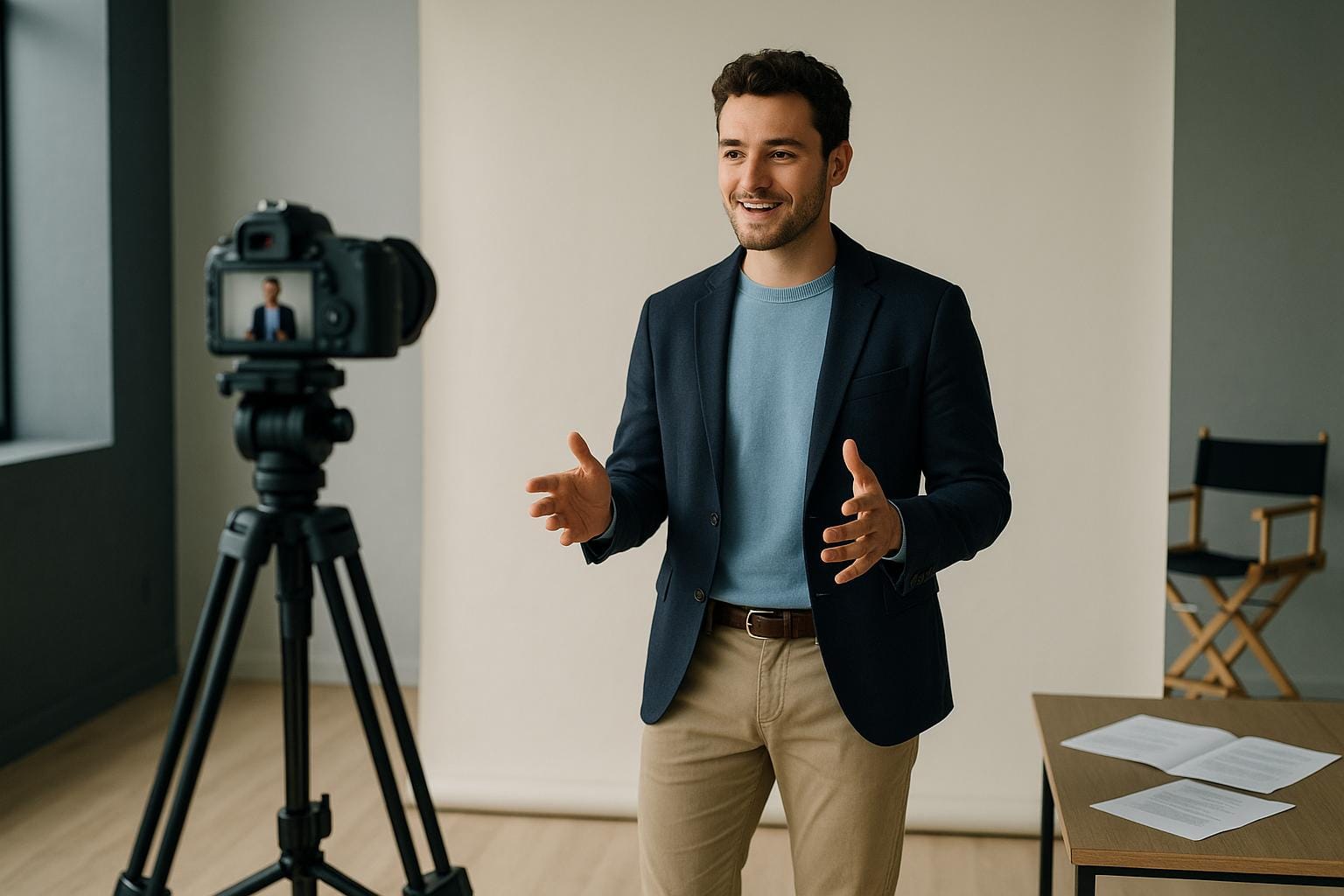What Casting Directors Look for in Backdrops
A neutral backdrop is essential for self-tape auditions, enhancing professionalism and ensuring casting directors focus on your performance.

When it comes to self-tape auditions, your backdrop is more important than you might think. It’s one of the first things casting directors notice, setting the tone for how they’ll perceive your professionalism and preparation. A clean, neutral backdrop ensures the focus stays on your performance, not on distracting backgrounds or clutter.
Key Takeaways:
- Use a single muted color like soft blue, gray, or off-white for your backdrop.
- Avoid patterns, wrinkles, or household items like bedsheets or curtains.
- Ensure proper lighting - natural light or soft studio lights work best.
- Follow specific instructions from casting directors regarding backdrop preferences.
Best backdrop for self-tape Auditions on an IphoneX | Different Skintones

Basic Requirements for a Neutral, Professional Backdrop
Casting directors are quick to spot even the smallest distractions, which is why having a neutral backdrop is key. It instantly communicates professionalism and shows that you understand what’s expected in today’s auditions.
What Makes a Backdrop Neutral and Professional
A professional backdrop is all about simplicity and focus. Stick to a single muted color like soft blue, gray, or off-white. These tones keep attention where it belongs - on you. The material should be smooth and free of wrinkles, whether it’s seamless paper or a plain fabric like muslin. Remove anything that could pull focus, like furniture or household clutter. Lighting also plays a big role - consistent, even lighting ensures there are no harsh shadows or bright spots that could distract from your performance. By meeting these standards, you can avoid the common missteps that might detract from your presentation.
Common Backdrop Mistakes to Avoid
Even small mistakes can make a big difference in how casting directors perceive your audition. Filming in cluttered spaces like kitchens or living rooms can be distracting, as can using patterned or wrinkled materials such as bedsheets or curtains. Moving objects - whether it’s a ceiling fan or a curious pet - are another no-go. Poor lighting, especially harsh overhead light, can cast unflattering shadows and ruin the polished look of your setup. And don’t overlook specific instructions from casting directors about backdrop colors, framing, or setup details. Ignoring these guidelines can hurt your chances of making the right impression.
Selecting the Right Colors and Materials
Once you’ve nailed the basics of setting up your backdrop, it’s time to focus on choosing the right colors and materials. The goal is to create a neutral, professional background that keeps all the attention on you.
Best Colors for Backdrops
When it comes to colors, soft blue is a fantastic choice. Its subtle tone works well with most skin tones and wardrobe options, while also adapting nicely to different lighting setups.
Gray is another reliable option. Opt for medium to light gray shades - they’re neutral, professional, and won’t overpower your presence on camera.
If you prefer a brighter look, off-white or cream can create an open and inviting feel. Just be cautious with your lighting to avoid overexposure or harsh reflections, which can be tricky with lighter tones.
On the flip side, steer clear of pure white. It often causes exposure issues and can wash out your features. Similarly, darker colors like black, navy, or deep green can lack contrast and sometimes create a distracting mood that takes away from your performance.
Materials to Consider
The material of your backdrop is just as important as the color. It needs to be smooth, consistent, and free of distractions.
- Seamless paper: A favorite in photography and film, this material offers a clean, professional look. However, it’s prone to tearing or wrinkling, so you might need to replace it often.
- Muslin fabric: This durable and washable option is great for long-term use. A tightly woven muslin, especially one made of cotton, will minimize unwanted textures or shine on camera.
- Canvas or duck cloth: These materials are tough, wrinkle-resistant, and built to last, though they come with a higher price tag upfront.
- Painted wall: If you have a dedicated space, a smooth wall painted in a matte, neutral color can work perfectly as a permanent backdrop. Just make sure it’s large enough for different framing needs and that your lighting setup remains consistent.
What should you avoid? Household items like bedsheets, curtains, or tablecloths. These often have distracting patterns, textures, or shiny finishes that can take away from the professional quality of your setup. Stick with materials designed for this purpose to ensure your backdrop enhances, rather than detracts from, your audition.
Setting Up Backdrops at Home
Creating a professional-looking backdrop at home doesn’t require a massive budget or a dedicated studio. With some clever tweaks, you can transform almost any space into a setup that will impress casting directors.
Budget-Friendly Backdrop Solutions
A blank wall is one of the easiest and most affordable options. If you’ve got a smooth, neutral-colored wall - think soft blue, gray, or off-white - you’re already set. Make sure the wall is free of distractions like hanging pictures, outlets, or light switches, and ensure it’s large enough to frame your shots properly.
If your walls aren’t ideal, wrinkle-free fabrics are a simple alternative. A cotton or polyester sheet in a neutral tone can work wonders. Look for wrinkle-resistant materials and secure them tightly using clamps or tape to keep the backdrop smooth and professional.
For those willing to spend a little, collapsible backdrop stands are a great option. You can find them online for under $50, and they’re portable, easy to set up, and perfect for shared spaces or filming in different locations.
Another affordable option is a pulldown screen or a tension rod system. Install a tension rod between two walls or a doorway and hang a neutral fabric backdrop. This setup is quick to assemble and dismantle, making it ideal for smaller or temporary spaces.
Feeling crafty? A DIY backdrop kit might be your go-to. With PVC pipes, clamps, and fabric from your local hardware or fabric store, you can build a custom backdrop that fits your space and style. It takes a little effort upfront, but it’s an inexpensive way to create a professional setup.
Once your backdrop is ready, focus on optimizing your camera placement and lighting to complete the look.
Proper Framing and Lighting Setup
Position your camera at eye level to ensure a natural and professional look. Casting directors typically prefer a moderate close-up shot, which frames you from your chest to just above your head. This allows them to see your facial expressions and upper body movements clearly. Use a tripod or a stable surface to keep your footage steady - shaky videos can detract from your performance.
When it comes to lighting, natural window light is your best friend. Position yourself so the light falls evenly across your face, avoiding harsh shadows under your eyes or nose. If you’re filming at night or in a dimly lit space, soft studio lights placed at a 45-degree angle can provide flattering illumination.
Stay away from overhead lighting, as it can cast unflattering shadows and make you appear tired. If shadows persist, try placing a small light behind you to add depth and prevent you from blending into the backdrop.
Consistency is key. Make sure your lighting setup is easy to replicate for multiple takes or auditions. Mark your positions for the camera, lights, and backdrop to ensure everything stays consistent.
Before you start filming, do a quick test recording. This helps you catch any issues with framing, lighting, or background distractions before it’s too late to fix them. Platforms like CastmeNow (Cast Me Now) make it easier to handle audition submissions, so you can focus on nailing the technical details that make your self-tapes stand out.
Following Casting Director-Specific Backdrop Requirements
Having a reliable default backdrop is important, but paying close attention to casting directors' specific instructions can make a big difference in your audition. These detailed requirements are not just about aesthetics - they're a way for casting teams to gauge your ability to follow directions, a critical skill in any professional setting.
Reading and Following Instructions
Start by carefully reading the casting notice, paying close attention to technical details. Casting directors often outline backdrop preferences tailored to the project's needs. Ignoring these guidelines could lead to your audition being overlooked, no matter how strong your performance is.
For example, some directors may specify backdrop colors to match the tone of the project or to avoid blending with costume colors. For a period drama featuring dark costumes, a light gray or cream backdrop might be recommended to create contrast.
Occasionally, directors may request a specific setting, like a "bedroom" or "kitchen" background, to see how you interact within a realistic environment. In such cases, a clean, uncluttered wall in your home might work perfectly. These details also influence how you frame your shot, whether it’s a close-up, medium, or wide angle.
Neutral backdrops are commonly preferred, but technical requirements can vary. Some directors might ask for a solid white background for green screen work or provide specific instructions about texture, reflectivity, or even backdrop dimensions. Always review any reference images they provide - matching these shows your attention to detail and professionalism.
You may also encounter auditions that require multiple backdrop setups to reflect different scenes or character types. For instance, you might need to create a "professional office look" for one scene and a "casual home environment" for another. Be prepared to switch between these setups efficiently.
It’s worth noting that the term "neutral backdrop" can mean different things depending on the project. One casting director might expect pure white, while another could prefer soft gray or beige. When in doubt, stick to the exact description provided instead of making assumptions.
Platforms like CastmeNow (Cast Me Now) can simplify the submission process, giving you more time to focus on perfecting these technical details. Following these instructions not only ensures your setup meets production needs but also highlights your ability to take direction - an essential trait for any actor. By consistently adhering to casting requirements, you enhance your self-tape’s overall impact and professionalism.
Conclusion: Creating a Backdrop That Works for Every Audition
Crafting a professional self-tape backdrop doesn’t have to be complicated. A simple, neutral, and distraction-free setup - like a blank wall, a light gray sheet, or an affordable backdrop kit - ensures casting directors stay focused on what truly matters: your performance.
The best backdrops share a few essential traits: they’re solid-colored, wrinkle-free, and completely neutral. Shades like white, gray, or light blue are versatile choices that work well for most auditions. This clean, understated look is key to presenting yourself professionally.
By having a consistent, ready-to-use backdrop setup, you can spend more time perfecting your performance rather than scrambling to find the right background every time. Whether you’re recording at home or on the go, this simple step highlights your commitment to professionalism.
With tools like CastmeNow streamlining the application process, you can focus on refining these technical details. While it might seem minor, your backdrop is one of the first things casting directors notice - it sets the tone before you even begin.
A carefully chosen backdrop doesn’t draw attention to itself; instead, it allows your talent to take center stage, reinforcing your image as a polished and prepared actor.
FAQs
Why should self-tape backdrops be free of patterns or clutter?
When it comes to self-tape auditions, the background you choose can make or break your presentation. A backdrop filled with patterns or cluttered with household items can pull attention away from your performance, making it harder for casting directors to stay focused on you. Instead, opt for a solid, neutral-colored background. This simple choice keeps the focus where it belongs - on your talent - and aligns with industry expectations for self-tapes. Simplicity is key to letting your skills shine without any unnecessary distractions.
How can I create consistent and professional lighting for my self-tape backdrop?
To create a polished and professional look for your self-tape backdrop, focus on using soft, diffused lighting to evenly light both yourself and the background. Position soft light sources - like softboxes or LED panels - at a 45-degree angle on either side of you. This setup helps reduce harsh shadows and ensures a balanced, flattering look. Adding a backlight or directing a light toward the backdrop can add depth and make you stand out against it.
Stick to a consistent color temperature - ideally between 5,000 and 5,600K - to mimic natural daylight and maintain a cohesive appearance across all takes. Avoid mixing light types, such as warm and cool tones, as this can create distracting inconsistencies. A straightforward and uniform lighting arrangement not only enhances the quality of your self-tape but also aligns with industry expectations.
How should I handle specific backdrop requirements from casting directors?
When casting directors share specific backdrop requirements, it's crucial to align with their preferences. Opt for a neutral, professional color like soft beige or gray - these shades are commonly used in the industry and complement most lighting setups. Make sure your backdrop is smooth, wrinkle-free, and free of any distractions.
Steer clear of busy or inappropriate settings like kitchens, doorways, or cluttered areas. A clean and simple backdrop not only keeps the focus on your performance but also showcases your professionalism and eye for detail, which can make a strong impression on casting directors.

